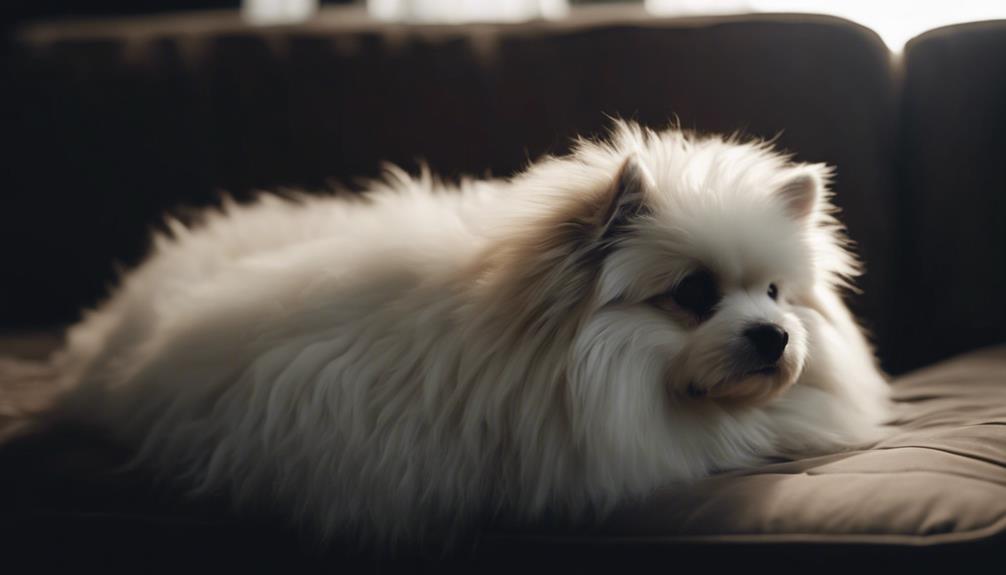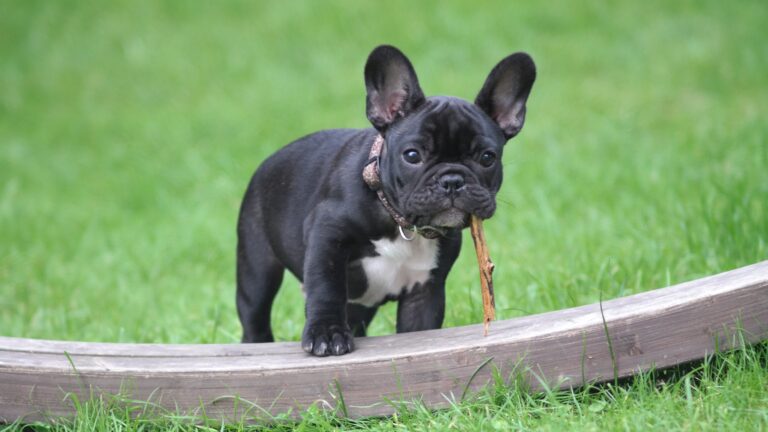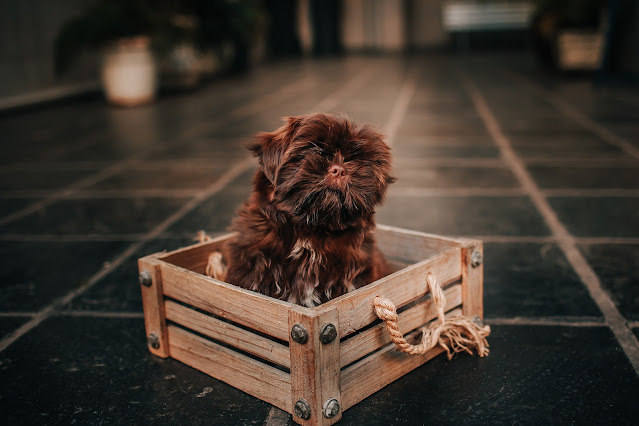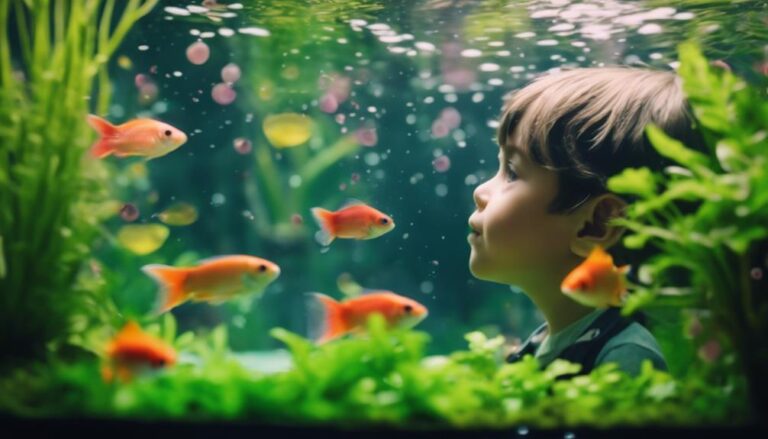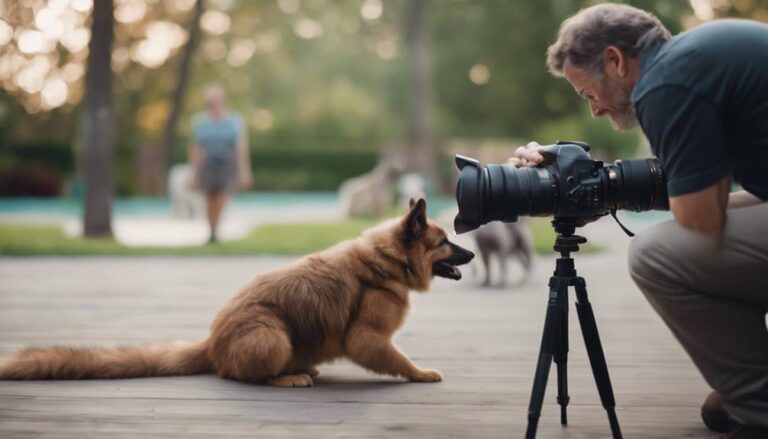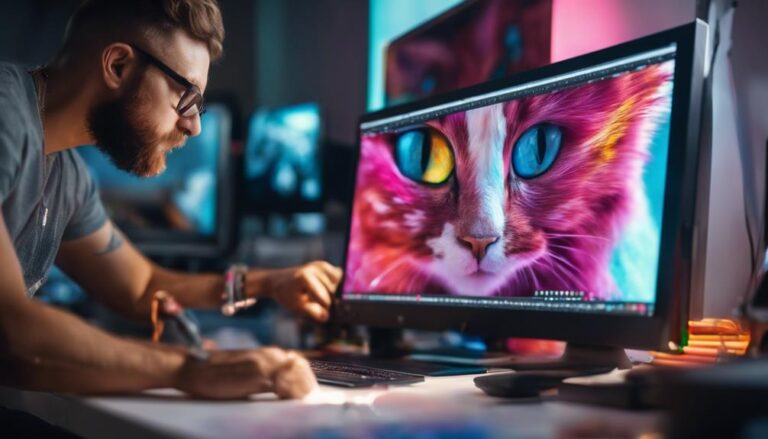When photographing pets, dealing with fur may seem tricky, but fret not! Groom your pet before the shoot to manage shedding. Use appropriate lighting to highlight fur textures. Opt for a background that complements your furry friend. Get creative with props to enhance your pet's fur. Capture action shots to show fur in motion. Remember, with the right techniques, you can capture your pet's beauty effortlessly.
Understanding Pet Fur
To capture the essence of your pet in photographs, understanding the characteristics of their fur is essential. The first step in maintaining your pet's fur for photography is to address shedding solutions and fur maintenance. Depending on your pet's breed and fur type, shedding can vary. Regular grooming and proper maintenance can greatly reduce shedding. Brushing techniques are vital in keeping your pet's fur healthy and photo-ready. For pets with thick fur, consider using a de-shedding brush to remove loose hairs effectively. This not only helps in fur maintenance but also enhances the overall appearance of your pet in photographs.
Understanding your pet's fur thickness is another key factor. Thicker fur may require more frequent brushing to prevent matting and tangling. By incorporating appropriate brushing techniques into your pet's grooming routine, you can ensure their fur looks sleek and well-kept in photos. Additionally, regular brushing stimulates the natural oils in your pet's skin, giving their fur a healthy shine.
Lighting Techniques for Fur
When capturing images of pets with fur, you'll want to take into account the type of lighting you use. Soft light can help create a gentle, flattering look on fur, while harsh light may emphasize imperfections. Backlighting can enhance the texture and details of the fur, adding depth and dimension to your pet portraits.
Soft Vs Harsh Light
Soft light is often the preferred choice when photographing pets with fur, as it creates a gentle and flattering effect that enhances the texture and details of their coat. When deciding between natural and artificial lighting, consider how each type affects the softness of the light. Natural light can provide a soft, diffused glow that works well to highlight the fur without harsh shadows. On the other hand, artificial lighting can be controlled to mimic soft natural light through techniques like using softboxes or bouncing light off walls. Employing soft focus techniques can further enhance the gentle look, blurring the background slightly to draw more attention to your pet's fur. Experiment with different lighting setups to find what works best for your furry friend.
Backlighting for Texture
Consider utilizing backlighting to enhance the texture of your pet's fur in your photographs. By incorporating natural backlighting techniques, you can create stunning images that highlight the intricate details of your pet's fur. Backlighting can help in creating silhouette portraits, adding a touch of mystery and elegance to your pet photography. Position your pet between the light source and your camera to capture the fur in a way that emphasizes its texture and depth. This technique works exceptionally well for pets with long or fluffy fur, as the light passing through the strands can create a beautiful halo effect, making your pet's fur appear soft and luscious in the final image.
Choosing the Right Background
When selecting a background for pet photography, focus on choosing colors that complement your pet's fur and bring out their features. Consider the texture of the background as well to add depth and interest to your photos. A well-thought-out background can elevate your pet portraits and make them truly stand out.
Background Color Selection
Why is selecting the right background color important when photographing pets? When choosing a background color for pet photography, consider color psychology and visual storytelling. Color psychology suggests that different colors can evoke various emotions and moods, influencing how viewers perceive the image. For example, blue backgrounds can convey a sense of calmness, while red backgrounds may evoke energy or excitement. Additionally, the background color can complement or contrast with the pet's fur, enhancing the overall composition of the photograph. In visual storytelling, the background color can help create a cohesive narrative or highlight the pet's unique characteristics. By carefully selecting the background color, you can elevate the impact of your pet photos and create visually appealing images.
Texture Considerations
To enhance the visual appeal of your pet photographs, pay attention to the texture of the background you choose. When considering fur patterns, opt for backgrounds with textures that contrast with your pet's fur. For example, if your pet has soft, fluffy fur, a rough or textured background can create a visually interesting contrast. On the other hand, if your pet has sleek fur, a smoother background might complement their coat better. By selecting backgrounds that play off your pet's fur patterns and provide contrast, you can add depth and visual interest to your pet photos. Experiment with different textures to find the perfect background that enhances your pet's unique characteristics in each shot.
Grooming Before the Photoshoot
Prior to capturing those ideal moments with your furry companion, make sure to groom them to enhance their appearance in photographs. Pre-shoot grooming plays an important role in ensuring that your pet looks their best. Start by brushing their fur to remove any tangles or mats. This not only improves their overall look but also helps in showcasing their fur texture more clearly in the photos. Regular fur maintenance, such as trimming overgrown fur around the eyes and paws, can also make a significant difference in how your pet appears in the pictures.
Additionally, giving your pet a bath before the photoshoot can help in making their coat look shiny and clean. However, be mindful of the timing, as bathing them too close to the shoot might leave their fur looking flat. Pay attention to their nails as well; trimming them will not only make your pet look more polished but also prevent any distractions in the photos.
Using Props to Highlight Fur
When capturing your pet's fur in photos, consider using props strategically. Props can create texture contrast, enhance fur colors, and highlight unique patterns. Experiment with different props to bring out the best in your pet's fur during the photoshoot.
Props for Texture Contrast
Consider incorporating small accessories like bows or bandanas to create a visually appealing contrast with your pet's fur. Here are some items that can help you enhance the texture contrast in your pet photography:
- Miniature flower crowns
- Checked scarves
- Synthetic fur blankets
- Hand-knitted sweaters
- Antique pins
Using these props creatively can add depth and interest to your pet portraits. Experiment with different combinations to highlight the unique textures of your pet's fur. By playing with textures and colors, you can create engaging compositions that make your furry friend stand out in photographs.
Enhancing Fur Colors
To enhance the colors of your pet's fur in photographs, utilize props strategically to highlight the natural hues and tones. When setting up your shot, consider using props that complement your pet's fur color, such as colorful toys or blankets. Additionally, you can adjust the color saturation during post-processing to make the fur tones more vibrant and true to life. Keep in mind that subtle color correction can also help in bringing out the richness of your pet's fur in the final image. Experiment with different props and editing techniques to find the perfect balance between enhancing the fur colors and maintaining a natural look.
Highlighting Unique Patterns
Enhance the visual appeal of your pet's fur patterns in photographs by strategically using props to highlight their unique textures and designs. To make your pet's fur artistry stand out, consider the following:
- Experiment with creative angles to capture the fur patterns in a new light.
- Use props to create abstract compositions that accentuate the uniqueness of the fur.
- Focus on capturing macro details to showcase the intricate patterns of the fur up close.
- Incorporate textures and colors in the background to complement the fur patterns.
- Play with light and shadows to add depth and dimension to the fur in your photographs.
Dealing With Shedding
Managing shedding can be challenging, but there are effective ways to minimize fur buildup in your pet's environment. Shedding prevention is key to keeping your home and your pet clean. Regular grooming is essential for controlling shedding. Brush your pet frequently with a deshedding tool appropriate for their fur type. This helps to remove loose fur before it ends up all over your furniture and clothes.
In addition to grooming, consider incorporating fur shedding solutions into your pet's diet. High-quality pet foods rich in omega-3 and omega-6 fatty acids can improve your pet's coat health, reducing excessive shedding. Make sure your pet stays hydrated as well, as dehydration can lead to dry skin and increased shedding.
Creating a designated space for your pet to rest can also help contain shedding. Use washable bedding and covers that can easily be cleaned to keep fur from accumulating in your home. Regularly wash these items to prevent the buildup of fur and dander.
Lastly, vacuuming and dusting your home regularly can further minimize the impact of shedding. Use a vacuum cleaner with a pet hair attachment to effectively remove fur from carpets, furniture, and other surfaces. By implementing these shedding prevention methods and fur shedding solutions, you can maintain a clean environment for both you and your furry friend.
Taming Static for Fluffy Pets
Dealing with shedding is just the beginning; now let's address taming static for your fluffy pets. Static control can be a real challenge when trying to capture the perfect photograph of your furry friend. Here are some grooming tips to help you tackle this issue:
- Use anti-static spray: Consider using a pet-safe anti-static spray to help reduce the static in your pet's fur before a photoshoot.
- Dryer sheets: Rubbing a dryer sheet over your pet's fur can help eliminate static electricity and keep their coat looking smooth.
- Humidifier: Increasing the humidity in the room where you're photographing your pet can help reduce static electricity in their fur.
- Regular grooming: Brushing your pet regularly not only helps prevent mats and tangles but can also reduce static by distributing natural oils throughout their coat.
- Avoid synthetic materials: When choosing props or accessories for your pet's photoshoot, opt for natural materials like cotton or wool to minimize static buildup.
Capturing Fur Texture
To truly showcase the unique texture of your pet's fur in photographs, make sure to capture it under ideal lighting conditions. When aiming to highlight the intricate details of your pet's fur, consider conducting a fur composition analysis. This involves examining the strands of fur, their thickness, length, and any distinguishing features that make your pet's fur special. By understanding these elements, you can tailor your photography approach to emphasize these unique characteristics.
Texture styling tips can also play a significant role in capturing the essence of your pet's fur. Experiment with different angles and lighting setups to see how they affect the appearance of the fur texture in your photos. Creative fur close-ups can offer a detailed look at the individual hairs and patterns, allowing for a more intimate portrayal of your pet's fur.
Furthermore, consider fur color enhancement techniques to make the texture of the fur stand out even more. Adjusting the saturation and contrast levels can help bring out the richness of your pet's fur color, adding depth to the overall texture captured in the photograph.
Focusing on the Eyes
When capturing photographs of pets, one important aspect to focus on is the eyes, as they are often the key to conveying emotion and creating a connection with the viewer. The eyes of a pet can speak volumes, allowing viewers to empathize with the subject and feel a sense of connection. Here are some tips to help you capture compelling pet eye photos:
- Establish Eye Contact: Encourage your pet to look directly at the camera to create a stronger connection with the viewer.
- Capture Emotion: Focus on the expressions in your pet's eyes to convey different emotions like joy, curiosity, or playfulness.
- Utilize Natural Light: Natural light can enhance the depth and color of your pet's eyes, making them appear more vibrant and expressive.
- Experiment with Angles: Try shooting from different angles to find the one that best highlights the unique qualities of your pet's eyes.
- Use Treats or Toys: Engage your pet with treats or toys to capture their attention and achieve lively, expressive eye photos.
Action Shots With Fur in Motion
Capturing action shots of pets with fur in motion can add a dynamic and energetic element to your photographs. When your furry friend is on the move, you have the opportunity to freeze frame those moments of agility and playfulness. To achieve this, use a fast shutter speed to capture sharp details and prevent motion blur. A shutter speed of at least 1/500 or higher is recommended to guarantee crisp images of your pet in action.
Freezing the frame is essential when your pet is moving quickly, such as during a playful sprint or a frisky jump. This technique allows you to capture the fur in motion, showcasing its texture and the excitement of the moment. Experiment with burst mode on your camera to increase the chances of getting that perfect freeze frame shot.
On the other hand, incorporating a bit of motion blur can also add a sense of speed and fluidity to your action shots. To achieve motion blur, try using a slightly slower shutter speed while following your pet's movement. This technique can create a dynamic effect, emphasizing the motion of the fur as your pet moves around. Strike a balance between freeze frames and motion blur to diversify your collection of action shots with fur in motion.
Editing Tips for Fur Clarity
Enhancing the clarity of fur in your pet photographs can be achieved through strategic editing techniques. When it comes to making your furry friend's coat stand out in photos, consider the following tips:
- Use the clone stamp tool: This tool can help you remove any distracting elements in the fur and create a more uniform look.
- Adjust the contrast: Increasing the contrast can make the individual strands of fur more defined, enhancing the overall texture.
- Focus on sharpness: Sharpening the image selectively can bring out the details in the fur without affecting other parts of the photo.
- Experiment with saturation: Increasing the saturation slightly can make the fur appear more vibrant and luscious.
- Utilize dodge and burn: Dodging can lighten specific areas of the fur, while burning can darken others, helping to create depth and dimension.
Group Shots and Fur Coordination
For cohesive group shots featuring pets with various fur patterns and colors, consider coordinating their coats to create a visually appealing composition. When organizing a photoshoot involving multiple pets, paying attention to fur fashion and styling can elevate the overall look of the images. Pet fur trends often include color coordination or contrast, which can be utilized to make the group shots more dynamic and interesting.
To achieve a harmonious group shot, think about the pets' fur colors and patterns. You can opt for a monochromatic theme where all pets have similar fur shades, creating a sense of unity. Alternatively, contrasting fur colors can add depth and visual interest to the composition. Experiment with different combinations to see what works best for the group you are photographing.
Another way to enhance group shots is by considering the length and texture of the pets' fur. Mixing long and short fur can create a visually appealing contrast, adding dimension to the photograph. Additionally, grooming the pets before the photoshoot can help achieve a polished look and make sure that their fur looks its best.
Showcasing Fur Patterns
When showcasing fur patterns in your pet photography, consider highlighting the unique textures and designs that add character to each animal. Capturing these details can take your photos to the next level, showcasing the beauty of your furry subjects in a creative and artistic way. Here are some tips to help you make the most out of fur patterns:
- Experiment with creative angles: Instead of always shooting from eye level, try getting down low or shooting from above to capture the fur patterns from different perspectives.
- Use natural light to enhance fur texture: Position your pet near a window or outdoors to make the fur textures pop and add depth to your photos.
- Focus on fur texture close-ups: Zoom in on specific areas where the fur pattern is most intricate to create visually appealing shots.
- Incorporate abstract compositions: Play with blurred backgrounds or unique framing to create artistic and eye-catching images that emphasize the fur patterns.
- Highlight contrasting fur patterns: If your pet has different fur textures or colors, showcase these variations in a single photo to create an interesting visual contrast.
Frequently Asked Questions
How Do I Prevent My Pet's Fur From Looking Flat or Dull in Photographs?
To prevent your pet's fur from looking flat or dull in photos, try fur styling and grooming tips. Experiment with lighting tricks and use editing tools to enhance texture and shine. These techniques will make your pet's fur stand out beautifully in pictures.
Are There Any Specific Camera Settings or Techniques I Should Use to Capture the Unique Colors and Patterns in My Pet's Fur?
To capture your pet's unique colors and patterns in photos, experiment with lighting tricks for depth. Adjust color balance to enhance fur hues. Use focus techniques to highlight details. In editing, refine colors for vividness and clarity.
How Can I Ensure My Pet's Fur Looks Shiny and Healthy in Photos?
To make your pet's fur look shiny and healthy in photos, follow these grooming tips: brush regularly to reduce tangles, use pet-safe shampoo for a clean coat, and consider adding a supplement for extra shine. Enhance with proper lighting tricks for a stunning finish.
What Are Some Creative Ways to Incorporate Different Textures of Fur Into My Pet Photography?
To add variety in your pet photography, experiment with different fur textures and styling. Mix it up with creative color contrasts to make your pet's coat stand out. These techniques can bring depth and interest to your photos.
How Can I Capture the Personality of My Pet Through Their Fur in Photographs?
To capture your pet's personality through their fur in photos, focus on their fur expressions and styling. Highlight unique patterns, colors, and textures. Embrace their natural look and incorporate it creatively into your photography to showcase their individuality.
Conclusion
Now that you have learned some tips and techniques for photographing pets with fur, you can confidently capture stunning images of your furry friends. Remember to take into account lighting, backgrounds, grooming, props, action shots, editing, group shots, and showcasing fur patterns to create visually appealing photos. With practice and patience, you'll be able to showcase the unique beauty of your pet's fur in all its glory. Happy photographing!

